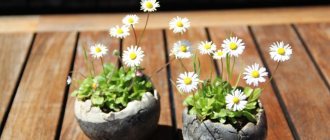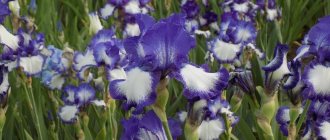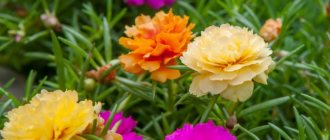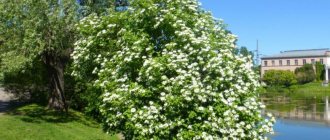Felt cherry, despite its name, is in close genetic connection with plum, cherry plum, apricot, and has a very distant relationship with ordinary cherry. The second name of the culture is Chinese cherry, although its homeland is also Korea and Mongolia. Felt cherry became widespread in Russia, as well as in the temperate latitudes of North America and Europe, around the middle of the 20th century. and immediately fell in love with gardeners for a number of advantages:
- Despite its small size, it produces 8-10 kg of berries, and with good care - up to 15 kg of fruit per plant;
- It is characterized by high frost and drought resistance;
- The shrub grows quickly and begins to bear fruit early;
- A distinctive feature is that the fruits do not fall off even after ripening;
- Felt cherry bushes are small in size and do not require large areas for planting;
- The plant is highly decorative both during and after flowering, so it will perfectly decorate any garden;
- Planting and care when growing felt cherries are simple and inexpensive, so growing the shrub is accessible even to amateurs.
What kind of cherry are you?
Who would have thought that in addition to the usual name, the felt cherry has several more names.
China and Mongolia are considered to be the birthplace of the plant. This is probably why it is often called Chinese cherry. Because of the delicate sweetness of their fruits, which differ from the sourish garden cherries, Chinese berries are also called baby cherries. It is noteworthy that in Kyrgyzstan, growing wild, it received the name chiya.
It’s strange that this crop is called cherry. In fact, it is a distant relative of the plum, but because of its round, small-shaped fruit, it received its current name.
This crop grows not like a tree, but like a bush. Its height is approximately 1.5 meters and it grows more in width than in height.
Although, without pruning and forming a bushy form, it can grow up to 3 meters. The cherry received the adjective to its name because of the white, felt-like fluff covering the bottom of its leaves.
To the description of the felt cherry, we can add that the fruits are small in shape, smaller than ordinary cherries. The berries sit on short petioles and, in their close proximity, resemble sea buckthorn.
Another feature of cherries is that they do not like loneliness. Next to it, experts advise planting 2-3 bushes of the same variety. The reason is that the felt cherry is self-sterile.
Although female and male flowers grow on it, it requires the presence of “brothers” and “sisters” to set fruit.
But despite the impossibility of cross-pollination with an ordinary cherry, gardeners note an interesting fact: the felt “namesake” growing nearby, while flowering simultaneously with the cherry tree, produces larger and juicier fruits.
Description
Chinese cherry, judging by the photo, looks like a low shrub with a lush crown. The plant is characterized by the following characteristics:
- height 1.0-2.5 m;
- the bark is gray-brown, darkening almost to black;
- leaves, fruits and shoots are slightly pubescent;
- leaves are teardrop-shaped and serrated;
- flowers are white and pink;
- fruits can be orange, pink and red;
- the fruits are placed very tightly on short petioles;
- the average weight of one berry is from 1.0 g to 4.5 g;
- The taste of the berries is sweet, almost without sourness.
Cons of growing
Felt cherry has few disadvantages and they are not significant. The flowering bush does not tolerate sudden spring frosts.
The lifespan of felt cherry is shorter than that of ordinary cherry. If a tree lives 50-60 years, then the bush will wither in 15-20 years.
Cherries are so delicate that they are difficult to transport. That is why it is not for sale on store shelves.
Health benefits and harms
Among the beneficial properties of cherries:
- improvement of intestinal motility;
- stimulates the functioning of the cardiovascular system;
- increases immunity;
- reduces the body's response to stress.
The fruits should not be eaten if a person has:
- stomach and duodenal ulcers;
- high sensitivity of tooth enamel;
- problems with intestinal disorders.
Choosing a sunny location
Before you have a berry beauty on your plot, decide on the choice of location. Cherry bushes do not like soil where groundwater comes close to the surface. Excess moisture will lead to rotting of the roots.
But if the area is very wet, choose elevated places for planting, or arrange drainage and outflow of excess water.
The bright beauty does not like heavy soil. If the soil is not suitable for it, but you really want to plant a flowering miracle, the heaviness of the soil is diluted with baking powder.
Felt cherry prefers to grow in sunny places for a reason. If the summer is rainy, the tender cherries of the bush will rot in a dark corner of the garden.
Questions - answers
Why does felt cherry dry out after flowering?
Most likely, this is a sign of fungal infection of the plant. All diseased branches must be removed and burned, and the bush should be treated with Zircon.
Why doesn't it bear fruit?
There may be several reasons: 1. There is only one bush on the site, and it does not have enough pollinators. It is worth planting 2-3 more plants nearby. 2. The soil is too wet. 3. The cherry has gone through its fruiting period, that is, it is too old to bear fruit. 4. Overly aggressive pruning was carried out.
The right purchase is the key to a good harvest
So, the place has been chosen, it’s time to purchase seedlings. Experts advise buying them not from hand or at the market, but from nurseries.
In specialized places, the felt cherry is grafted; after planting and with proper care, it will quickly take root and the fruits on it will be large. When bargaining at the market, you are not insured against buying a wild bush that has grown from a seed. The berries of such a sprout will be small, 1-2 cm, no more.
If you made a purchase in the fall, do not plant the sprout in open ground for the winter. It is better to plant it in a large bucket with loose soil or sand, and put it in the basement for the winter.
When purchasing a seedling in the spring, pay attention to the absence of awakening buds on it. If the purchase occurred in the fall, then the cherry tree should not have leaves.
Landing
Preparation for planting felt cherries includes several stages:
Cherries are planted in early April
Carefully inspect the seedling. Dry and damaged roots must be removed. The central root is cut off to allow the lateral roots to branch out.
The tops also need to be leveled. The longest branches are shortened to the level of the rest.
For planting, a hole is dug 50 cm deep and the same width. Advice! In order for the bush to take root well, it is recommended to plant it at the same depth at which it grew in the nursery (this is noticeable by the marks on the trunk).
The hole is filled one third with well-rotted humus, potash and phosphate fertilizers.
A seedling is placed in the dug hole, covered with soil that remains after digging, and compacted tightly.
A small hole is formed around the trunk so that when watering, water reaches the roots.
The seedling is well watered, and then the hole is mulched to retain moisture.
The remaining trees are planted in the same way at a distance of 2 meters from each other. When designing a “living” hedge, bushes are planted at a shorter distance.
Variety of varieties
Whatever variety you choose, take note of the following advice: to prevent the fruits from becoming smaller, felt cherries growing in bushes must be thinned out, removing excess branches. If this procedure is carried out regularly, the bush tree can bear fruit for several years.
It would seem that an ordinary felt cherry bush is capable of growing from a seed, whatever varieties it may have. It turns out that home gardeners have plenty to choose from.
Knowing the name of the variety, it is not difficult to understand the characteristics of a particular species and choose the one that is suitable for growth, fruiting and climate.
"Natalie"
Tall bushes reach 1.8 meters in height. The variety is suitable for beginning agronomists because it is unpretentious, resistant to winter frosts, summer drought and spring frosts.
But the plant cannot tolerate waterlogging—the roots, foliage and fruits rot. The harvest will delight you with large berries weighing up to 4 grams.
Variety "Summer"
Mother of many felt cherry species. If you want to reap a good harvest from it at the end of July (up to 9 kg per bush), protect the plants from the codling moth, which is partial to this variety.
Bushes of medium height are strewn with very large fruits weighing up to 5 grams.
"Alice"
Medium-sized bush with red berries, 3-4 grams each.
"Queen"
The description of this variety of felt cherry deserves special attention. Low-growing bushes will be of interest not only from the point of view of harvesting, but also of landscape design.
The variety is great for creating hedges. Bushes 1.2 meters high in July give a generous harvest. Gardeners collect 10 kg of berries from one bush.
"White"
This variety is suitable for those who want to add something unusual among the felt cherry bushes.
Rare for Chinese cherries, the white fruits are not inferior in taste to their red counterparts. The fruits are small, 2 grams each, but their yield is up to 8 kg per bush.
"Damanka"
Another variety with non-standard fruits. Small dark burgundy berries on two-meter bushes yield a yield of up to 9 kg.
All varieties have several factors in common: the fruits are juicy, sour-sweet, their pulp is difficult to separate from the seeds
The berries are ideal for making jam and compotes, but are absolutely not suitable for transportation and long-term storage due to their delicate skin.
Diseases and pests
| Disease | Signs | Fighting methods |
| Moniliosis (fungal disease) | Flowers and leaves dry out for no apparent reason and fall off. Flowers may acquire a copper-brown color. | All affected branches must be removed and burned, otherwise other trees will be at risk. Plants are treated with a solution of antifungal agents, for example, Topaz, strictly following the instructions. |
| Clusterosporiasis (hole spotting) | Brown growths and cracks appear on the branches. The buds swell, and small dark spots appear on the leaf blades. | The plant must be treated with one of the drugs: “Horus”, “Kuproksat”; "Skor." |
| Coccomycosis | A reddish rash appears on the leaf blades, spores are visible on the underside of the leaf, and the leaves fall off. The cherry tree loses its resistance to frost and as a result dies. | The plant can be treated with a solution of Bordeaux mixture or the preparations “Skor” or “Chorus”. |
| Pocket disease | A sign of the development of the disease will be the appearance of unusual elongated fruits. | The fruits are removed, the affected branches are burned, and the plant is treated with fungicides. |
Pests
They parasitize Chinese cherry:
- aphid;
- plum moth;
- leaf roller;
- plum mite
Timely treatments with insecticides help in the fight against parasites.
Note to home breeders
To grow cherry bushes yourself, you do not need to be an agronomist breeder. Felt cherry is propagated by cuttings, layering and seeds.
The option of growing bushes from seeds is suitable for creating green fences. In this case, the yield is not important, because the offspring from the seeds cannot boast of large fruits.
Reproduction
You can get new plants using standard methods:
- Germinating seeds. However, you need to be sure that the seed belongs to a varietal and not a hybrid plant, otherwise the resulting sprout will not retain the properties of the parent plant.
- Cuttings. An effective method of propagating cherries allows you to quickly obtain a viable seedling that retains the properties of the parent plant.
- By layering. Refers to vegetative methods of propagation, which will guarantee the preservation of the qualities of the mother plant in the new shoot.
Bone kids
The germination rate of Chinese cherry seeds is quite high—7-8 seeds germinate out of ten seeds. Planting material is harvested in the summer.
The seeds, washed and cleared of pulp, are dried (not in the sun!) and stored until October, mixed with sand.
In the fall, having chosen a permanent place for the bushes, make a furrow 6 cm deep, plant the seeds, sprinkle with sawdust and cover with earth on top. In the spring, seedlings will appear, which will reach half a meter in height by autumn.
Multiply by cuttings
Varieties that produce large berries are propagated by cuttings. Several shoots 10-15 cm long are cut from the selected bush, tied into a bundle and soaked in any growth stimulant for a day.
Then each cutting is planted in a nutrient substrate to a depth of at least 3 cm and covered with film.
Move to the side
“Cloning” the mother bush is not a difficult procedure and is carried out in the spring, as soon as the snow melts.
They select the freshest shoot from last year, bend it to the ground, place it in a pre-prepared groove, and cover it with soil, compacting it.
For closer contact with the ground, it is recommended to “pin” the branch with a spear or bent wire. Don’t forget to water it all summer and by autumn the cuttings will take root.
Felt cherry is not difficult to care for and even the most inexperienced amateur can grow it. And if the plant is surrounded with care, attention and love, it will certainly reward you with lush flowering and a generous harvest of vitamins.
Why do we love her?
She's delicious! Not at all like ordinary cherries: the taste is not so rich and the color too. This cherry is tender, one continuous sweet-sour juice with its own subtle aroma. As a result, it is almost impossible to find it on sale - it is neither transportable nor lightweight.
Generous. Like sea buckthorn - all the branches are in the berries. And there is enough for everyone. By the time the cherries ripened in the Khabarovsk Territory, the surrounding trees were thickly covered with sparrows - they were guarding the ripening of the cherry fruits. If the cherries on the top branches have already been thoroughly pecked, right down to the pit, then it’s time to pick. The plant itself is dense, with numerous small shoots; sparrows do not get inside the bush.
The ripening period is cherry happiness not only for sparrows. Cherries are eaten “from the belly” - as many as you can fit. We had three mature cherry bushes that allowed us, our friends and relatives, and our son’s friends to eat enough; there was still enough left for preparations. With a harvest every year, it has no frequency of fruiting.
Cherries, as a rule, do not fall off even when fully ripe, so those not found during the main picking are discovered later - the sweetest ones.
Some digression: I became acquainted with the felt cherry as a child, in the Moscow region: my mother, who lived for some time in the Far East, was fascinated by this plant and planted several bushes in our garden. But such flowering and such abundant fruiting that I saw in the Khabarovsk Territory did not exist in the Moscow region. I can’t say anything about Kuban yet; the cherry is still lonely and “pulls” only on its self-fertility. We'll see later.
And she is also very beautiful. Graphic in winter, incredibly poetic in bloom, cheerful in young leaves, catchy and generous in summer and picturesque in autumn attire.
In continental regions it is also loved for its ease of cultivation. The worst pests are mice, which gnaw the bark in winter, and chipmunks, which steal crops. Cooperation with chipmunks directly suggests itself: after all, they only need the bones, and we only need the pulp.
Felt cherry, variety “Okeanskaya Virovskaya”. © lph-syrajevka.
Felt cherry, “White” variety. © Royal Garden
Felt cherry, variety “Tsarevna”. © zlatpitomnik











